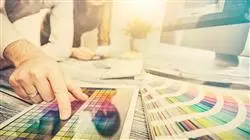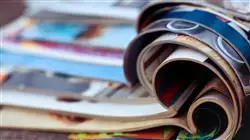University certificate
The world's largest faculty of design”
Introduction to the Program
A complete program that will enable you to work in the different fields of Editorial Design, with specific knowledge of the factors that influence and determine the success of a publication"

Every designer must start their profession with a solid knowledge of the history of design, which will allow them to understand how current trends have been reached and what are the mechanisms that allow a design to be successful and relevant in a particular social, cultural or historical moment.
This concept of general culture will be taken to the territory of audiovisual culture. The graphic design professional needs to know the audiovisual phenomena that move in the same paradigms as graphic communication. The influence of some media on others, the different combinations of media and the new graphic products that incorporate different techniques and approaches from other communicative areas are a knowledge that will open new lines of thought and work.
In this sense, having knowledge in all possible aspects of work is a gateway to very interesting possibilities and new avenues to explore.
Therefore, this program will address the aspects that a designer needs to know in order to plan, develop and finalize any graphic project. An educational path that will scale up the student's competencies to help them achieve the challenges of a top professional.
Graphic design is presented as a viable option for a professional who decides to work independently, but also to be part of any organization or company. An interesting avenue for professional development that will benefit from the specific knowledge that TECH makes available to you.
You will be able to delve into the most international professional practice thanks to the masterclasses included in this complete program"
This Professional master’s degree in Editorial Design contains the most complete and up-to-date program on the market. The most important features include:
- The development of a large number of case studies presented by experts
- Graphic, schematic, and highly practical contents
- The latest developments and cutting-edge advances in this field
- Practical exercises where the self-evaluation process can be carried out to improve learning
- Innovative and highly efficient methodologies
- Theoretical lessons, questions to the expert, debate forums on controversial topics, and individual reflection assignments
- Content that is accessible from any fixed or portable device with an Internet connection
A comprehensive analysis of the cultural and aesthetic phenomena that affect the criteria for the creation of graphic communication"
The Development of this Course is Focused on the Practice of the Proposed Theoretical Learning Through the most effective teaching systems, proven methods imported from the most prestigious universities in the world, you will be able to acquire new knowledge in a practical way. In this way, we strive to convert your efforts into real and immediate skills.
Our online system is another of the strengths of our educational proposal. With an interactive platform that has the advantages of the latest technological developments, we put the most interactive digital tools at your service. In this way we can offer you a totally adaptable way of learning for your own specific needs, so you can combine this training perfectly with your personal and professional life.
A practical and intensive learning that will give you all the tools in ideation, development and creation of any graphic project you need to work in this field"

A training program created to allow you to implement your acquired knowledge into your daily practice in an almost immediate way.
Why study at TECH?
TECH is the world’s largest online university. With an impressive catalog of more than 14,000 university programs available in 11 languages, it is positioned as a leader in employability, with a 99% job placement rate. In addition, it relies on an enormous faculty of more than 6,000 professors of the highest international renown.

Study at the world's largest online university and guarantee your professional success. The future starts at TECH”
The world’s best online university according to FORBES
The prestigious Forbes magazine, specialized in business and finance, has highlighted TECH as “the world's best online university” This is what they have recently stated in an article in their digital edition in which they echo the success story of this institution, “thanks to the academic offer it provides, the selection of its teaching staff, and an innovative learning method aimed at educating the professionals of the future”
A revolutionary study method, a cutting-edge faculty and a practical focus: the key to TECH's success.
The most complete study plans on the university scene
TECH offers the most complete study plans on the university scene, with syllabuses that cover fundamental concepts and, at the same time, the main scientific advances in their specific scientific areas. In addition, these programs are continuously being updated to guarantee students the academic vanguard and the most in-demand professional skills. In this way, the university's qualifications provide its graduates with a significant advantage to propel their careers to success.
TECH offers the most comprehensive and intensive study plans on the current university scene.
A world-class teaching staff
TECH's teaching staff is made up of more than 6,000 professors with the highest international recognition. Professors, researchers and top executives of multinational companies, including Isaiah Covington, performance coach of the Boston Celtics; Magda Romanska, principal investigator at Harvard MetaLAB; Ignacio Wistumba, chairman of the department of translational molecular pathology at MD Anderson Cancer Center; and D.W. Pine, creative director of TIME magazine, among others.
Internationally renowned experts, specialized in different branches of Health, Technology, Communication and Business, form part of the TECH faculty.
A unique learning method
TECH is the first university to use Relearning in all its programs. It is the best online learning methodology, accredited with international teaching quality certifications, provided by prestigious educational agencies. In addition, this disruptive educational model is complemented with the “Case Method”, thereby setting up a unique online teaching strategy. Innovative teaching resources are also implemented, including detailed videos, infographics and interactive summaries.
TECH combines Relearning and the Case Method in all its university programs to guarantee excellent theoretical and practical learning, studying whenever and wherever you want.
The world's largest online university
TECH is the world’s largest online university. We are the largest educational institution, with the best and widest online educational catalog, one hundred percent online and covering the vast majority of areas of knowledge. We offer a large selection of our own degrees and accredited online undergraduate and postgraduate degrees. In total, more than 14,000 university degrees, in eleven different languages, make us the largest educational largest in the world.
TECH has the world's most extensive catalog of academic and official programs, available in more than 11 languages.
Google Premier Partner
The American technology giant has awarded TECH the Google Google Premier Partner badge. This award, which is only available to 3% of the world's companies, highlights the efficient, flexible and tailored experience that this university provides to students. The recognition as a Google Premier Partner not only accredits the maximum rigor, performance and investment in TECH's digital infrastructures, but also places this university as one of the world's leading technology companies.
Google has positioned TECH in the top 3% of the world's most important technology companies by awarding it its Google Premier Partner badge.
The official online university of the NBA
TECH is the official online university of the NBA. Thanks to our agreement with the biggest league in basketball, we offer our students exclusive university programs, as well as a wide variety of educational resources focused on the business of the league and other areas of the sports industry. Each program is made up of a uniquely designed syllabus and features exceptional guest hosts: professionals with a distinguished sports background who will offer their expertise on the most relevant topics.
TECH has been selected by the NBA, the world's top basketball league, as its official online university.
The top-rated university by its students
Students have positioned TECH as the world's top-rated university on the main review websites, with a highest rating of 4.9 out of 5, obtained from more than 1,000 reviews. These results consolidate TECH as the benchmark university institution at an international level, reflecting the excellence and positive impact of its educational model.” reflecting the excellence and positive impact of its educational model.”
TECH is the world’s top-rated university by its students.
Leaders in employability
TECH has managed to become the leading university in employability. 99% of its students obtain jobs in the academic field they have studied, within one year of completing any of the university's programs. A similar number achieve immediate career enhancement. All this thanks to a study methodology that bases its effectiveness on the acquisition of practical skills, which are absolutely necessary for professional development.
99% of TECH graduates find a job within a year of completing their studies.
Professional Master's Degree in Editorial Design
Editorial design is one of the oldest disciplines in the creation of communicative pieces, its evolution over the years has provided different formulas for success that allow the professional to perform ideally and connect with the consumer in an optimal way. The Professional Master's Degree in Editorial Design at TECH Global University is presented as an excellent opportunity for academic qualification, because we have high quality multimedia educational content, which will allow applicants to create a new conceptual background in the latest innovations and trends in the editorial field. In addition, the new skills obtained will enable them to design and lead the creation of communicative pieces based on market guidelines and customer desires.
Postgraduate Certificate in Editorial Design 100% online
TECH's postgraduate course will allow students to develop projects for the creation of traditional media such as books, newspapers, magazines, as well as digital products focused on web design, an aspect that is the main focus of distribution today. Similarly, focusing on improving the practical skills of students, we have a state-of-the-art audiovisual teaching system, through which they will solve simulated situations based on real life. In this way, applicants will be prepared for the different challenges and problems they will face during their professional practice, while at the same time they will easily and quickly internalize the thematic axes taught throughout the Postgraduate Certificate.







